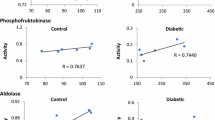Abstract
Development of insulin-dependent diabetes mellitus in children is accompanied by essential disturbances in the peripheral subdivision of the erythron system, manifested in enhanced cell polymorphism, imbalance in the composition of membrane phospholipids and their increased microviscosity, reduced lipoprotein concentration, and enhanced reversible aggregation. These disturbances are most pronounced during metabolic decompensation accompanied by ketoacidosis, which agrees with the hypothesis on their role in the development of vascular complications.
Similar content being viewed by others
References
T. S. Balashova, E. N. Tomilova, M. I. Balabolkin, and A. A. Kubatiev,Ter. Arkh.,68, No. 2, 53–56 (1996).
Yu. A. Vladimirov and G. E. Dobretsov,Fluorescent Probes in the Study of Biological Membranes [in Russian], Moscow (1980).
G. I. Kozinets and Yu. Simovart,The Surface Architectonics of Peripheral Blood under Normal Conditions and during Blood System Diseases [in Russian], Tallin (1984).
A. A. Kubatiev, T. S. Balashova, M. I. Balabolkin, and E. N. Tomilova,Byull. Eksp. Biol. Med.,122, No. 7, 109–113 (1996).
A. G. Maksina, N. P. Mikaelyan, B. A. Dainyak, and Yu. A. Knyazev,Biofizika,39, No. 3, 475–478 (1994).
E. M. Simovan'yan and E. K. Alimova,Vopr. Med. Khim., No. 2, 28–33 (1984).
T. I. Turkina, L. F. Marchenko, L. V. Sapelkina,et al., Probl. Endokrinol.,40, No. 3, 6–10 (1994).
R. T. Tukhvatulin, V. N. Shuvaeva, N. Kh. Shadrina, and V. A. Levtov,Fiziol. Zh. SSSR,72, No. 6, 775–784 (1986).
M. C. Barenbaum,Q. J. Micr. Sci.,99, 231–242 (1958).
J. Gehotsky,Bratisl. Lek. Listy,95, No. 3, 103–106 (1994).
M. Chevremont and U. Frederic,Arch. Biol.,54, 589–593 (1943).
J. Folch, M. Lees, and G. H. Sloane-Stanley,J. Biol. Chem.,226, No. 1, 497–509 (1957).
A. Othmane, M. Bitbol, P. Snabre, and P. Mills,Eur. Biophys. J.,18, No. 2, 93–99 (1990).
C. Watala,Ann. Acad. Medlozensis.,33, Nos. 3–4, 5–33 (1992).
C. Watala and P. Winocour,Eur. J. Clin. Chem. Clin. Biochem.,30, No. 9, 513–519 (1992).
Author information
Authors and Affiliations
Rights and permissions
About this article
Cite this article
Novitskii, V.V., Kolosova, M.V., Kravets, E.B. et al. Structural and metabolic status and functional peculiarities of erythrocytes in children with insulin-dependent diabetes mellitus. Bull Exp Biol Med 128, 959–962 (1999). https://doi.org/10.1007/BF02438097
Received:
Issue Date:
DOI: https://doi.org/10.1007/BF02438097



